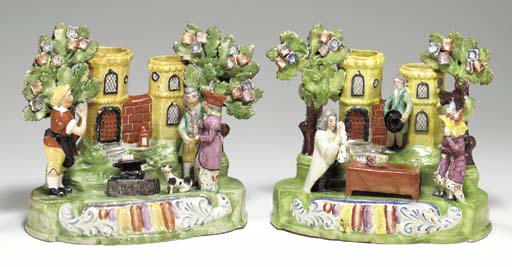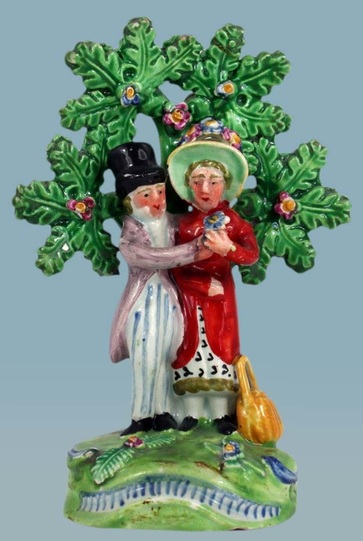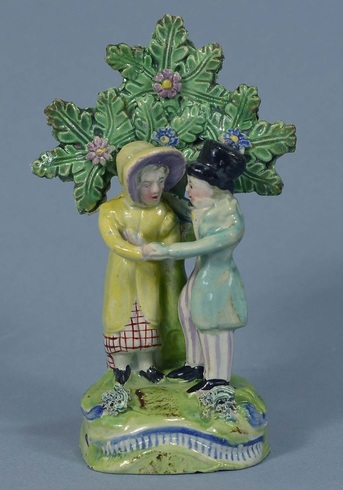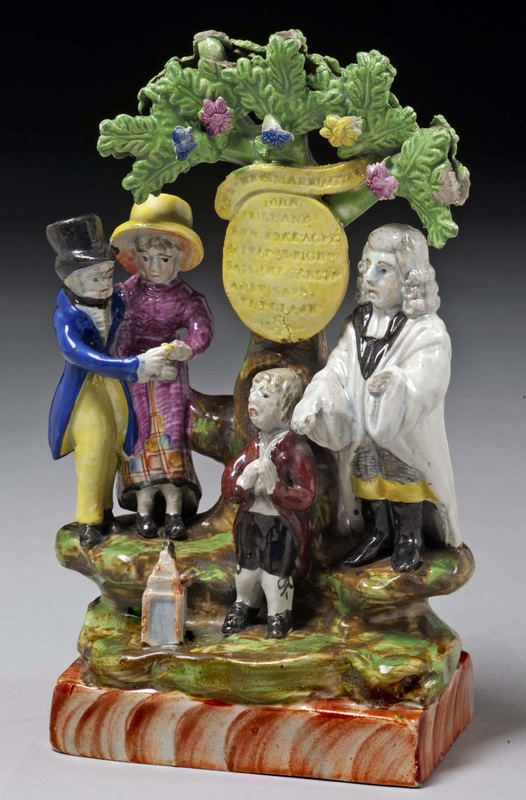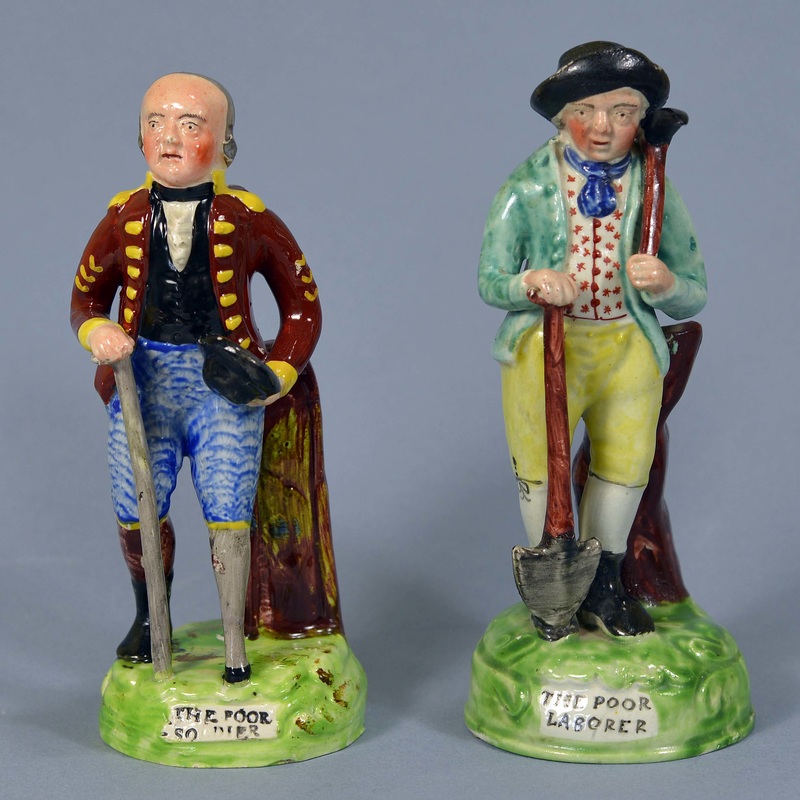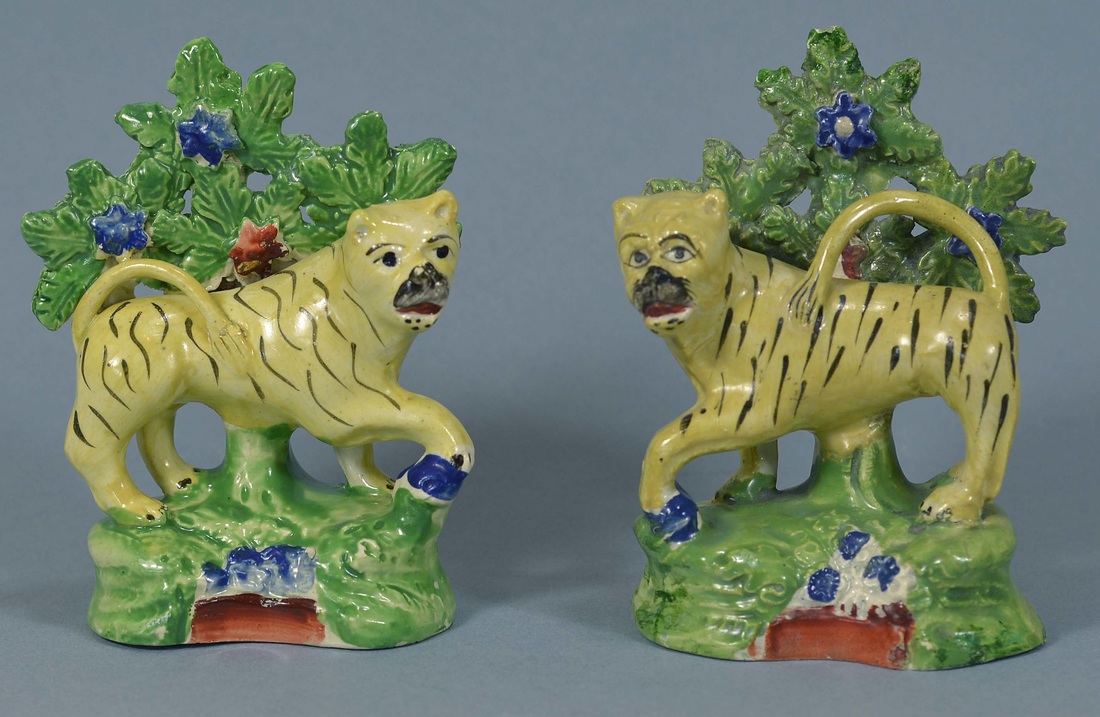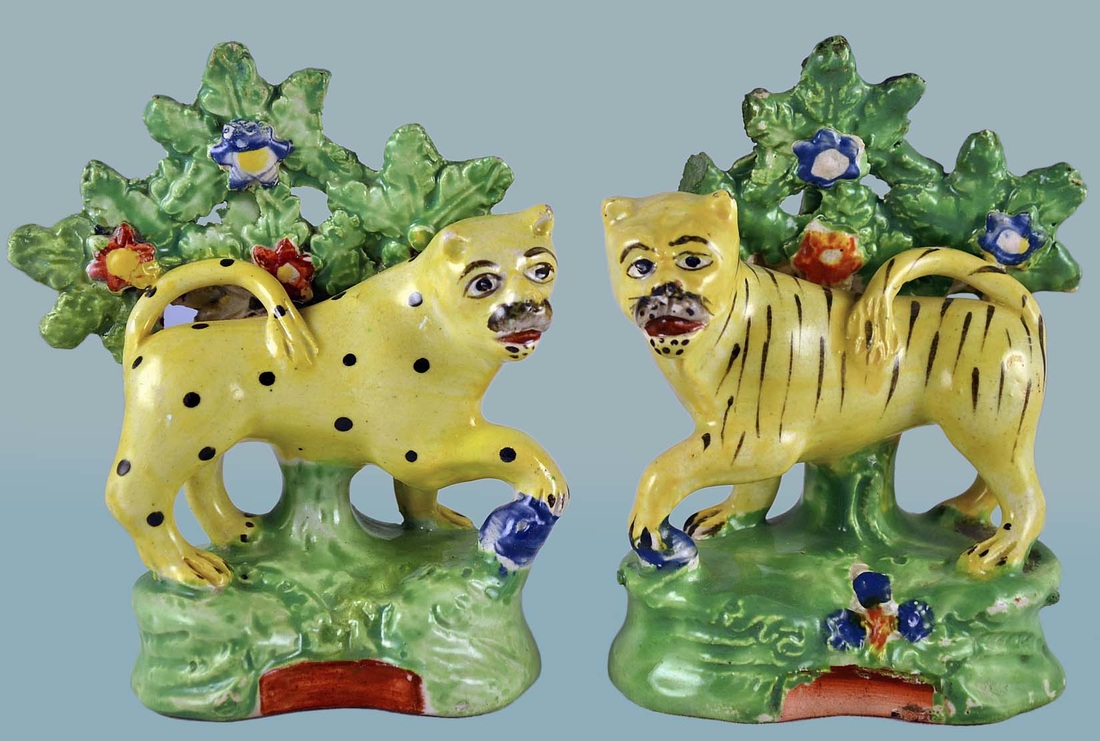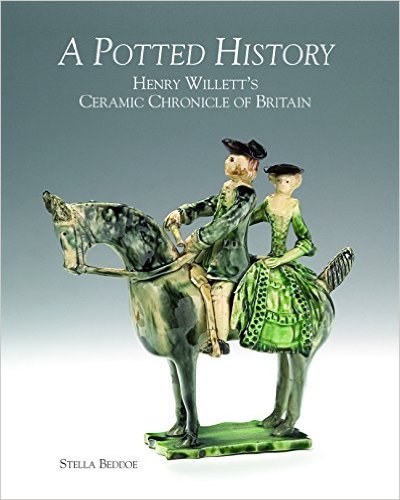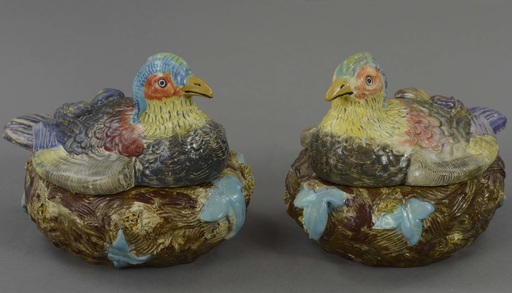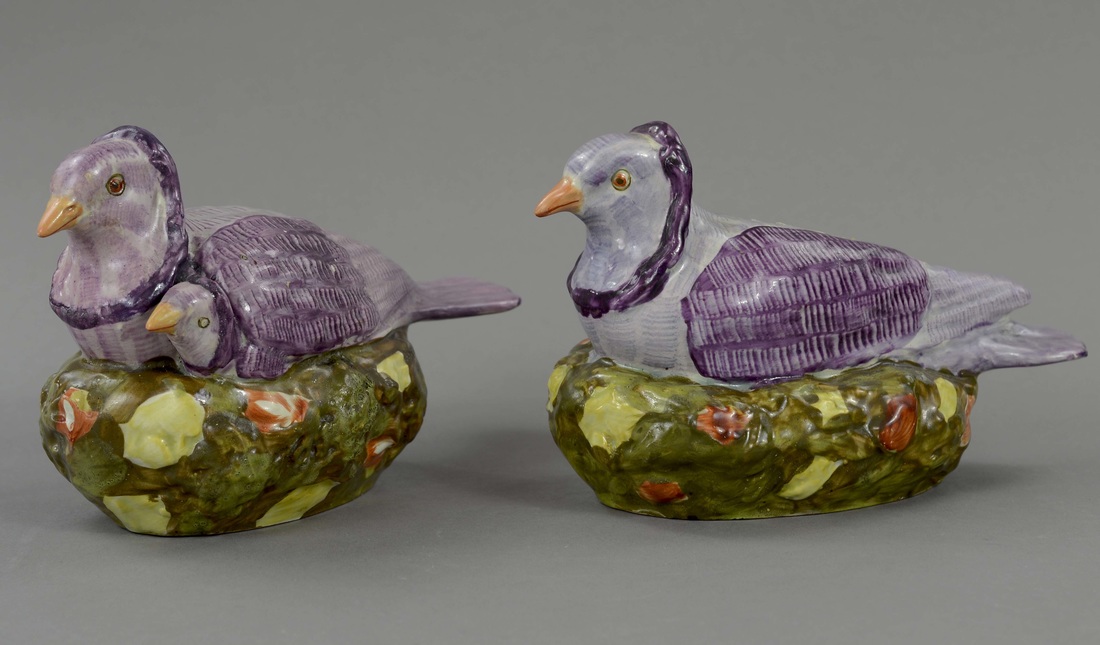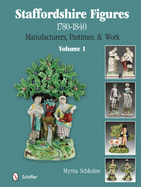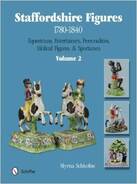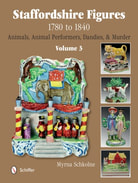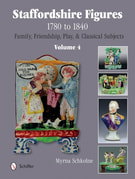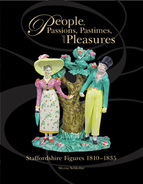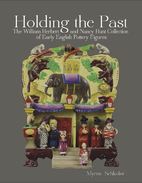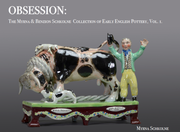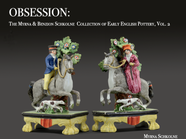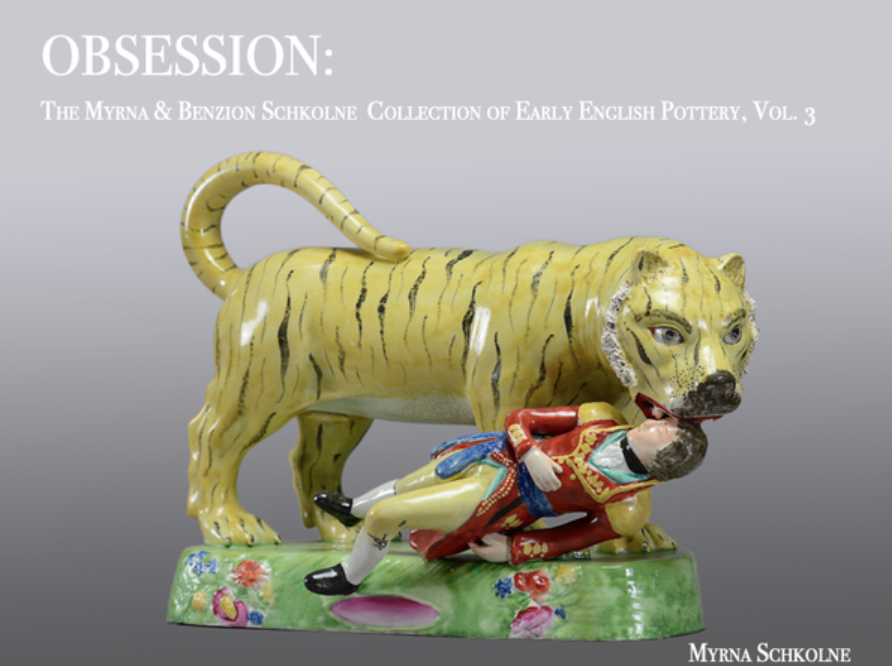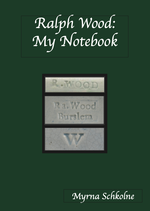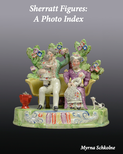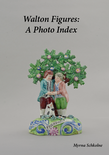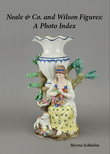I am not saying that EVERY figure has a companion--but I am surprised at how very many do. And of course finding a companion when one least expects it is one of the true joys of collecting.
|
Early Staffordshire figures, in very many cases, have a "mate." I deliberately avoid the word "pair" because often the figures are companion pieces rather than the other side of a true pair. Thus, the "Sherratt" christening and wedding groups below were designed to stand side by side. They are perfect companion pieces, but either one looks just fine standing on its own. I am always on the look-out for companion pieces, figures that should or could stand side by side. Of course, not every Staffordshire figure group has a companion, but recently I have had a run of luck. For example, I have always thought the tiny couple below to be one of those little gems that stand alone. I know of only two examples, so it really is a rare teeny treasure. It is about 5 inches high. To my surprise, I recently found the even rarer companion piece, below. As you see, here the figures are reversed, so I think these two models were designed to stand side by side. Note that on this version, the group was made without a handbag on the ground. I was very happy recently to complete another twosome. My THE POOR SOLDIER, below, finally got a THE POOR LABORER to stand beside him. Yay! Of course, there seem to be figures that seem to be true pairs rather than companions. I have owned the tiger on the left for quite a while, so I was pleased to find the tiger on the right to complete the twosome. I attribute these to John Hall. But are these tigers a true pair or are they companion figures? In the case of quite a few feline models, I suspect that the potters sold the animals individually rather than as pairs. The buyer could buy one or two, as he or she wished. In the case of the Hall felines, it was possible to make your pair in assorted ways. Would you prefer a tiger and leopard side by side? Not a problem! ! I have noticed this mix-and match phenomenon with the array of lions made by the "Patriotic Group" pot bank (See Staffordshire Figures 1780-1840, Volume 3.)
I am not saying that EVERY figure has a companion--but I am surprised at how very many do. And of course finding a companion when one least expects it is one of the true joys of collecting.
0 Comments
The Willett Collection of early English pottery, held at the Brighton Museum, UK, is my all time favorite collection. I was transfixed when I fist saw it thirty years ago, and my enthusiasm for it has not dimmed with the passing of time. Stella Beddoe worked at the museum as Keeper of Decorative Art and, later, Senior Keeper, from 1978 to 2012. She loves the Willett Collection, and her enthusiasm for it is palpable. Stella didn't just do her job. Rather, she cherished the Willett Collection. She generously shared her time and the Willett's treasures with me on several occasions. What a privilege it was to learn from someone with her great depth of knowledge of the history encapsulated in this fabulous collection.
At last, Stella's long-awaited book on the Willett Collection has been published. I believe it will be available in the UK in October and in the US at the end of November. I can't wait to get my copy. Buy this book. You will love it! For collecting inspiration, I look no further than the Staffordshire figures on John Howard's site. The plethora of goodies in his stock in unparalleled. This week, a particularly pretty pearlware pigeon tureen caught my eye. So why a tureen in the shape of a pigeon? Today, we don't eat pigeons, but for much of the nineteenth century, the pigeon was standard poultry for the dinner table, and there was no shortage of pigeon recipes. Pigeons were served in broth, pies, and stews; they could be roasted, brazed, glazed, or trussed and served whole. And what better way to present a pigeon course than in a pigeon-shaped tureen? Today, early Staffordshire pigeon tureens are very difficult to find. The Hunt Collection is home to the really pretty pair, below. Very many figures in the Hunt Collection were acquired decades ago, and now it is virtually impossible to find them. I can't recall seeing a pair of pigeon tureens like these. They have become scarcer than hen's teeth--or should it be pigeon's teeth? So if you like John's bird, don't hold out for a pair. The Hunt Collection never ceases to surpass expectations. To add to its pair of pigeon tureens, it has yet another pair of figural pigeons of a different sort. This time, each bird (below) is a nun pigeon, the name given the variety of pigeon with a raised ruffle of feathers around the head. And yes, one has a baby...very sweet! Notice that these pigeons are NOT tureens. They were made to be purely decorative. If you have not bought Holding the Past: the William Herbert and Nancy Hunt Collection of Early English Pottery Figures, do so. I have no hesitation in shamelessly plugging the book because I know that every collector will drool over its pages. This collection's treasures never cease to amaze.
|
Archives
February 2024
All material on this website is protected by copyright law. You may link to this site from your site, but please contact Myrna if you wish to reproduce any of this material elsewhere. |
